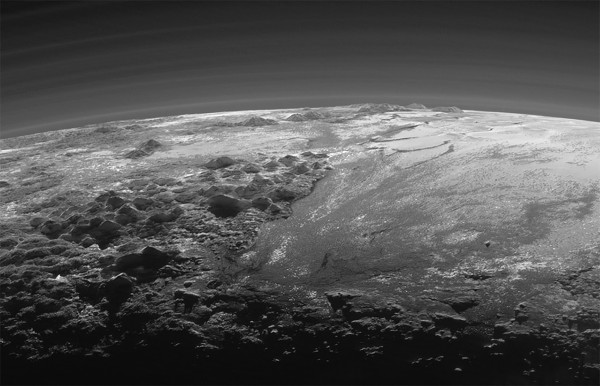NASA Spacecraft Takes Latest Pictures of Pluto's Atmosphere and Terrain
| Benjie Batanes | | Sep 18, 2015 07:30 AM EDT |
(Photo : REUTERS/NASA/JHUAPL/SwRI/Handout via Reuters) A close-up view of the rugged, icy mountains and flat ice plains on Pluto is seen in an image from NASA's New Horizons spacecraft taken July 14, 2015 and released September 17, 2015. The expanse of the informally named icy plain Sputnik Planum (R) is flanked to the west (L) by rugged mountains up to 11,000 feet (3,500 meters) high. The image was taken from a distance of 11,000 miles (18,000 kilometers) to Pluto.
NASA has released photographs taken by one of its spacecrafts as it flew by Pluto on July 14. The pictures released on Thursday has provided scientists with details about the unique environment in Pluto.
The BBC reported that New Horizons passed by Pluto more than two month ago but the images were only received by scientists on Sunday. The pictures were taken while the craft was only 13,000 kilometers away from Pluto's surface.
Like Us on Facebook
New Horizon is equipped with a sophisticated wide angle camera and was able to capture more than a thousand kilometers panoramic view of the dwarf planet. The images showed an icy planet with mountain ranges, plains and gigantic glaciers.
The spacecraft was able to use the sun as a back-light which enabled its camera to take clear and sharp pictures of Pluto. The surface is filled with various layers cloud formations that obscures many parts of the dwarf planet.
Arizona based Lowell Observatory spokesperson Will Grundy said the spacecraft not only brought dramatic images of Pluto, but it has also revealed that the weather there changes daily.
The images included more detailed view of the Norgay and Hillary ice mountain ranges in Pluto. Scientists are well aware that it atmosphere is composed of mostly nitrogen, but weather conditions in Pluto share similarities with that of Earth.
The ice in Pluto is primarily composed nitrogen which melts, evaporates and hardens again. The icy landscape could be mistaken for Antarctica or Greenland.
NASA scientist Professor Alan Stern said they were surprised that Pluto has a similar weather system like Earth despite its nitrogen-based atmosphere.
New Horizons left Earth in 2006 and reached Jupiter a year later. The spacecraft is currently hurtling in space at around 48,000 kilometers per hour, making it the fastest man-made probe ever built.
The next mission for the space probe is to take close pictures of another Pluto-like object located near the Kuiper Belt.
TagsPluto, New Horizons, NASA, space probe, pluto images, Pluto Flyby, Nitrogen atmosphere, dwarf planet, Pluto glaciers, Norgay mountain range, Hillary ice mountain
©2015 Chinatopix All rights reserved. Do not reproduce without permission
EDITOR'S PICKS
-

Did the Trump administration just announce plans for a trade war with ‘hostile’ China and Russia?
-

US Senate passes Taiwan travel bill slammed by China
-

As Yan Sihong’s family grieves, here are other Chinese students who went missing abroad. Some have never been found
-

Beijing blasts Western critics who ‘smear China’ with the term sharp power
-

China Envoy Seeks to Defuse Tensions With U.S. as a Trade War Brews
-

Singapore's Deputy PM Provides Bitcoin Vote of Confidence Amid China's Blanket Bans
-

China warns investors over risks in overseas virtual currency trading
-

Chinese government most trustworthy: survey
-

Kashima Antlers On Course For Back-To-Back Titles
MOST POPULAR
LATEST NEWS
Zhou Yongkang: China's Former Security Chief Sentenced to Life in Prison

China's former Chief of the Ministry of Public Security, Zhou Yongkang, has been given a life sentence after he was found guilty of abusing his office, bribery and deliberately ... Full Article
TRENDING STORY

China Pork Prices Expected to Stabilize As The Supplies Recover

Elephone P9000 Smartphone is now on Sale on Amazon India

There's a Big Chance Cliffhangers Won't Still Be Resolved When Grey's Anatomy Season 13 Returns

Supreme Court Ruled on Samsung vs Apple Dispute for Patent Infringement

Microsoft Surface Pro 5 Rumors and Release Date: What is the Latest?













